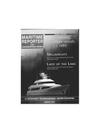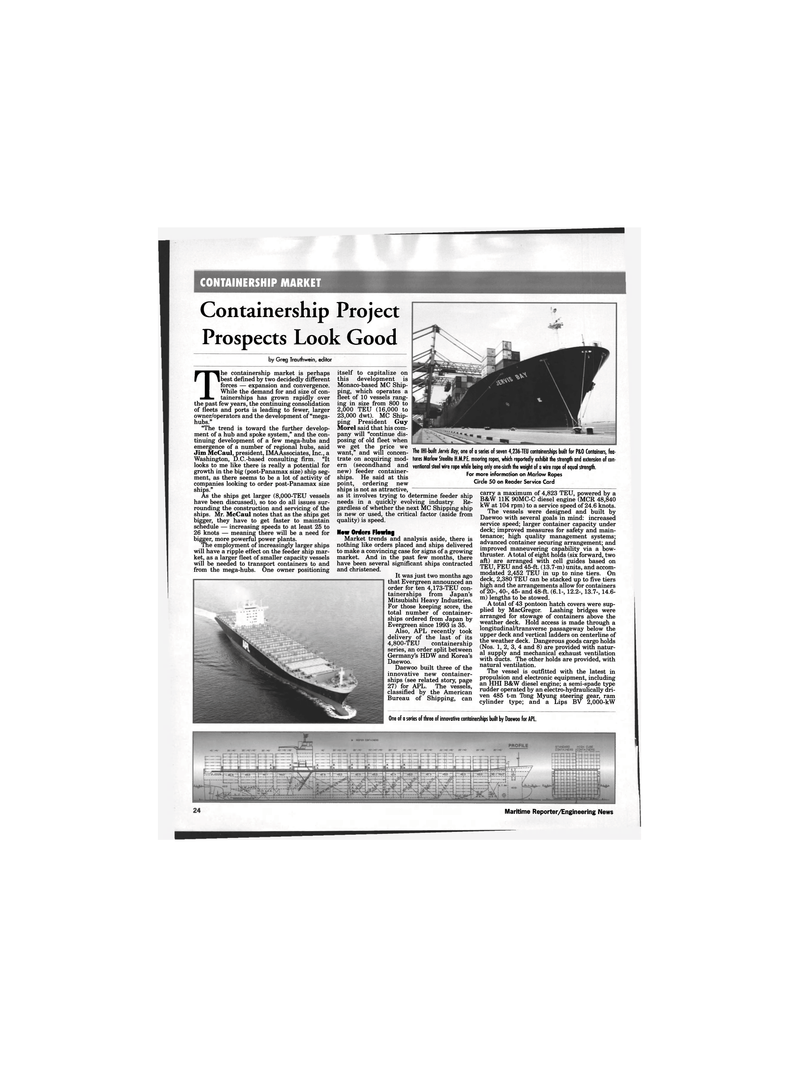
Page 22: of Maritime Reporter Magazine (January 1996)
Read this page in Pdf, Flash or Html5 edition of January 1996 Maritime Reporter Magazine
CONTAINERSHIP MARKET 38D Maritime Reporter/Engineering News by Greg Trauthwein, editor
Containership Project
Prospects Look Good
One of a series of three of innovative containerships built by Daewoo for APL.
The containership market is perhaps best defined by two decidedly different forces — expansion and convergence. While the demand for and size of con-tainerships has grown rapidly over the past few years, the continuing consolidation of fleets and ports is leading to fewer, larger owner/operators and the development of "mega- hubs." "The trend is toward the further develop- ment of a hub and spoke system," and the con- tinuing development of a few mega-hubs and emergence of a number of regional hubs, said
Jim McCaul, president, IMAAssociates, Inc., a
Washington, D.C.-based consulting firm. "It looks to me like there is really a potential for growth in the big (post-Panamax size) ship seg- ment, as there seems to be a lot of activity of companies looking to order post-Panamax size ships."
As the ships get larger (8,000-TEU vessels have been discussed), so too do all issues sur- rounding the construction and servicing of the ships. Mr. McCaul notes that as the ships get bigger, they have to get faster to maintain schedule — increasing speeds to at least 25 to 26 knots — meaning there will be a need for bigger, more powerful power plants.
The employment of increasingly larger ships will have a ripple effect on the feeder ship mar- ket, as a larger fleet of smaller capacity vessels will be needed to transport containers to and from the mega-hubs. One owner positioning itself to capitalize on this development is
Monaco-based MC Ship- ping, which operates a fleet of 10 vessels rang- ing in size from 800 to 2,000 TEU (16,000 to 23,000 dwt). MC Ship- ping President Guy
Morel said that his com- pany will "continue dis- posing of old fleet when we get the price we want," and will concen- trate on acquiring mod- ern (secondhand and new) feeder container- ships. He said at this point, ordering new ships is not as attractive, as it involves trying to determine feeder ship needs in a quickly evolving industry. Re- gardless of whether the next MC Shipping ship is new or used, the critical factor (aside from quality) is speed.
Now Orders Flowing
Market trends and analysis aside, there is nothing like orders placed and ships delivered to make a convincing case for signs of a growing market. And in the past few months, there have been several significant ships contracted and christened.
It was just two months ago that Evergreen announced an order for ten 4,173-TEU con- tainerships from Japan's
Mitsubishi Heavy Industries.
For those keeping score, the total number of container- ships ordered from Japan by
Evergreen since 1993 is 35.
Also, APL recently took delivery of the last of its 4,800-TEU containership series, an order split between
Germany's HDW and Korea's
Daewoo.
Daewoo built three of the innovative new container- ships (see related story, page 27) for APL. The vessels, classified by the American
Bureau of Shipping, can
The IHI-built Jervis Bay, one of a series of seven 4,236-TEU containerships built for P&O Containers, fea- tures Marlow Steelite H.M.P.E. mooring ropes, which reportedly exhibit the strength and extension of con- ventional steel wire rope while being only one-sixth the weight of a wire rope of equal strength.
For more information on Marlow Ropes
Circle 50 on Reader Service Card carry a maximum of 4,823 TEU, powered by a
B&W 11K 90MC-C diesel engine (MCR 48,840 kW at 104 rpm) to a service speed of 24.6 knots.
The vessels were designed and built by
Daewoo with several goals in mind: increased service speed; larger container capacity under deck; improved measures for safety and main- tenance; high quality management systems; advanced container securing arrangement; and improved maneuvering capability via a bow- thruster. A total of eight holds (six forward, two aft) are arranged with cell guides based on
TEU, FEU and 45-ft. (13.7-m) units, and accom- modated 2,452 TEU in up to nine tiers. On deck, 2,380 TEU can be stacked up to five tiers high and the arrangements allow for containers of 20-, 40-, 45- and 48-ft. (6.1-, 12.2-, 13.7-, 14.6- m) lengths to be stowed.
A total of 43 pontoon hatch covers were sup- plied by MacGregor. Lashing bridges were arranged for stowage of containers above the weather deck. Hold access is made through a longitudinal/transverse passageway below the upper deck and vertical ladders on centerline of the weather deck. Dangerous goods cargo holds (Nos. 1, 2, 3, 4 and 8) are provided with natur- al supply and mechanical exhaust ventilation with ducts. The other holds are provided, with natural ventilation.
The vessel is outfitted with the latest in propulsion and electronic equipment, including an HHI B&W diesel engine; a semi-spade type rudder operated by an electro-hydraulically dri- ven 485 t-m Tong Myung steering gear, ram cylinder type; and a Lips BY 2,000-kW

 21
21

 23
23
